Comparing Top RFP Software: Responsive vs Competitors
Responding to RFPs can consume hours of your day, revising old content, checking consistency, and coordinating inputs across multiple contributors

Responding to RFPs can consume hours of your day, revising old content, checking consistency, and coordinating inputs across multiple contributors. Meanwhile, competitors submit polished, well-structured proposals faster, leaving you struggling to keep up and losing valuable opportunities.
The shift to automation is clear. The global RFP software market was valued at USD 2.62 billion in 2024 and is projected to reach USD 5.78 billion by 2032, growing at a CAGR of 10.5%. This growth demonstrates that an increasing number of companies are adopting advanced RFP solutions to save time and enhance outcomes.
Once a popular choice, Responsive is no longer your only go-to option. New AI-powered RFP platforms have entered the market, offering faster response creation, smarter collaboration, and actionable insights.
That is why more sales and proposal leaders are comparing Responsive with newer competitors. Some tools prioritize content management, others focus on collaboration, while the latest AI-driven platforms emphasize speed, accuracy, and win potential. The real question is: which solution helps you respond faster, reduce effort, and close more deals?
Key Takeaways
- Responsive’s Position: Once the go-to platform for RFP management, Responsive now faces competition from faster, more intelligent AI-driven tools.
- Market Shift: Companies are moving toward automation-focused RFP software that reduces manual work and increases proposal accuracy.
- Key Comparisons: Tools like Loopio, PandaDoc, and Qvidian help with content management and collaboration, but lack Inventive AI’s advanced automation and contextual intelligence.
- Key Selection Factors: Focus on automation power, integrations, content intelligence, support, and overall cost of ownership when choosing software.
- Why Inventive Wins: Inventive AI delivers real-time collaboration, AI-driven content reuse, and centralized knowledge—all while ensuring compliance and measurable results.
What Is RFP Software and Why Does It Matter
Responding to RFPs is one of the most time-consuming tasks for sales and proposal teams. The demand for better solutions is apparent. The global proposal management software market was valued at USD 2.33 billion in 2023 and is projected to grow to USD 5.81 billion by 2032, at a CAGR of 12.2%. The numbers reflect a clear truth: organizations are done wasting time on manual work that AI can handle better.
RFP software addresses this challenge by automating manual steps, organizing approved content, and enabling faster collaboration across teams. Modern platforms even use AI-driven recommendations to surface the best responses and improve consistency across proposals.
The benefits are measurable:
- Reduce response times by up to 90%
- Improve content accuracy to 95%
- Increase win rates by 50%
And this shift matters more than ever. In a market where speed and accuracy define revenue outcomes, proposal delays can cost you deals. While competitors rely on automation to submit polished responses in days, manual processes can slow your pipeline for weeks. That’s why more sales leaders are rethinking their tech stack and comparing Responsive with newer AI-powered RFP platforms designed to help them respond faster, win smarter, and grow revenue predictably.
Key Features of Responsive RFP Software
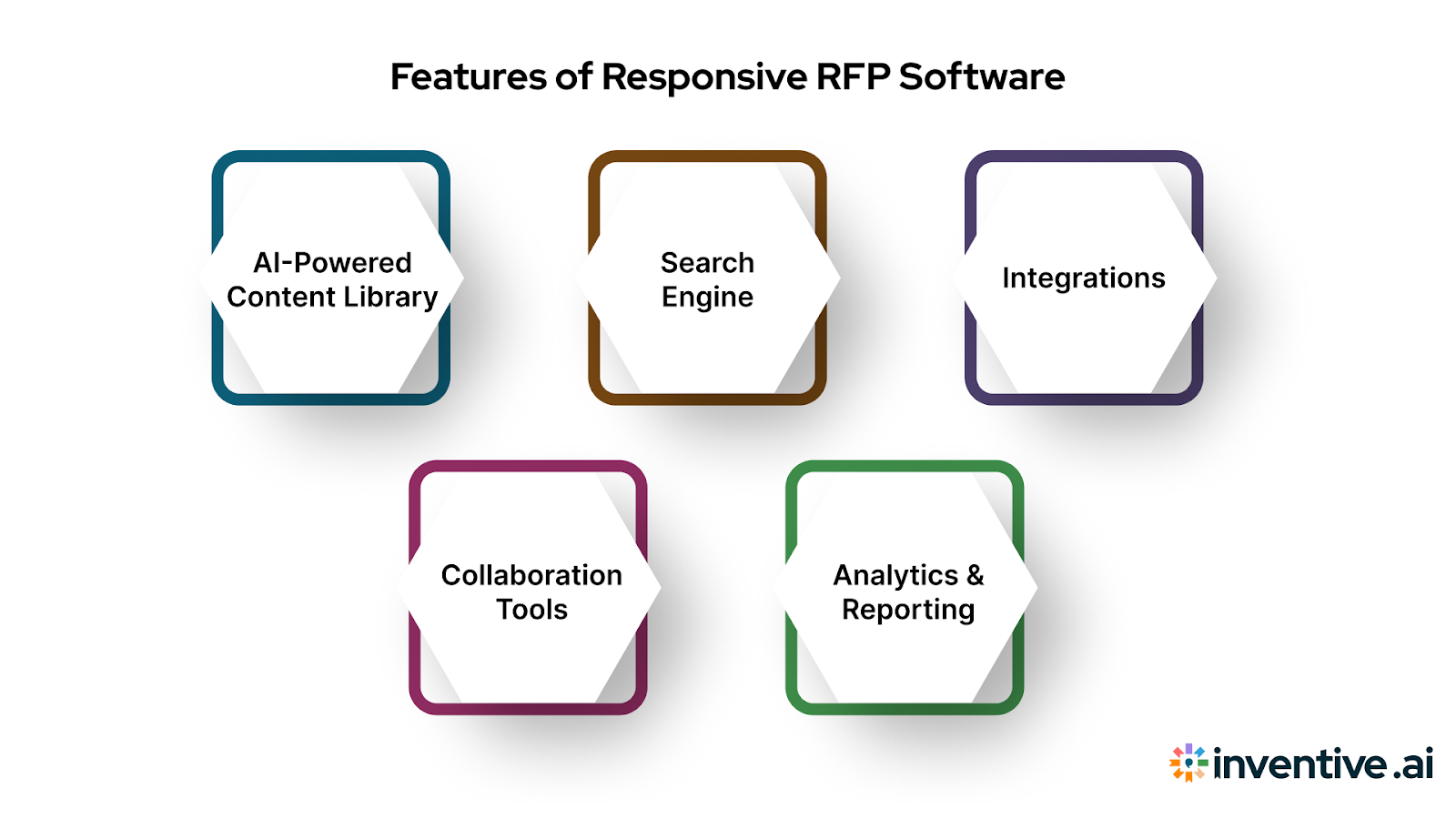
When evaluating RFP tools, you need to look at features that actually move the needle for your sales cycle. Responsive RFP software is built to handle large, complex requests and give your team more control over responses. Here are the key features that matter:
- AI-Powered Content Library: Store approved answers and reuse them instantly. Instead of reinventing the wheel, your team pulls accurate responses that cut hours of work.
- Collaboration Tools: Assign roles, tag SMEs, and track progress in real time. This ensures everyone contributes without slowing the process.
- Search and Recommendation Engine: The software suggests the best responses based on past success, raising both speed and consistency.
- Analytics and Reporting: Track submission timelines, measure response quality, and understand which proposals drive higher win rates.
- Integrations: Connect with CRMs, sales enablement tools, and content management systems so your teams don’t work in silos.
These features give you a sharper advantage when competing for complex deals. If your current process takes weeks, responsive RFP software helps you deliver accurate proposals in days. For sales leaders, the difference directly translates into more revenue opportunities and higher efficiency across teams.
This is where Inventive AI sets itself apart. With an AI RFP Agent that cuts response times by 90%, delivers 95% accuracy, and raises win rates by 50%, Inventive AI is built for revenue-focused teams that want measurable results, not just faster proposals, but stronger outcomes.
Also Read: The Ultimate Guide to Software RFPs: How to Write and Respond to Software RFPs
Top 10 Competitors to Responsive
Responding to RFPs consumes a significant portion of your sales and proposal team’s time. Teams can spend up to 30% of their month on RFP responses, affecting revenue and deal closure speed. Choosing the right RFP software improves efficiency, ensures accuracy, and accelerates win rates.
Responsive now faces growing criticism for its steep learning curve, limited AI functionality, and slower response automation compared to newer solutions. Many organizations are beginning to explore more agile and intelligent alternatives that better match modern sales demands.
Below is a detailed comparison of the top competitors to Responsive RFP software, including Inventive AI, the industry’s most advanced and intelligent alternative to Responsive.
1. Inventive AI
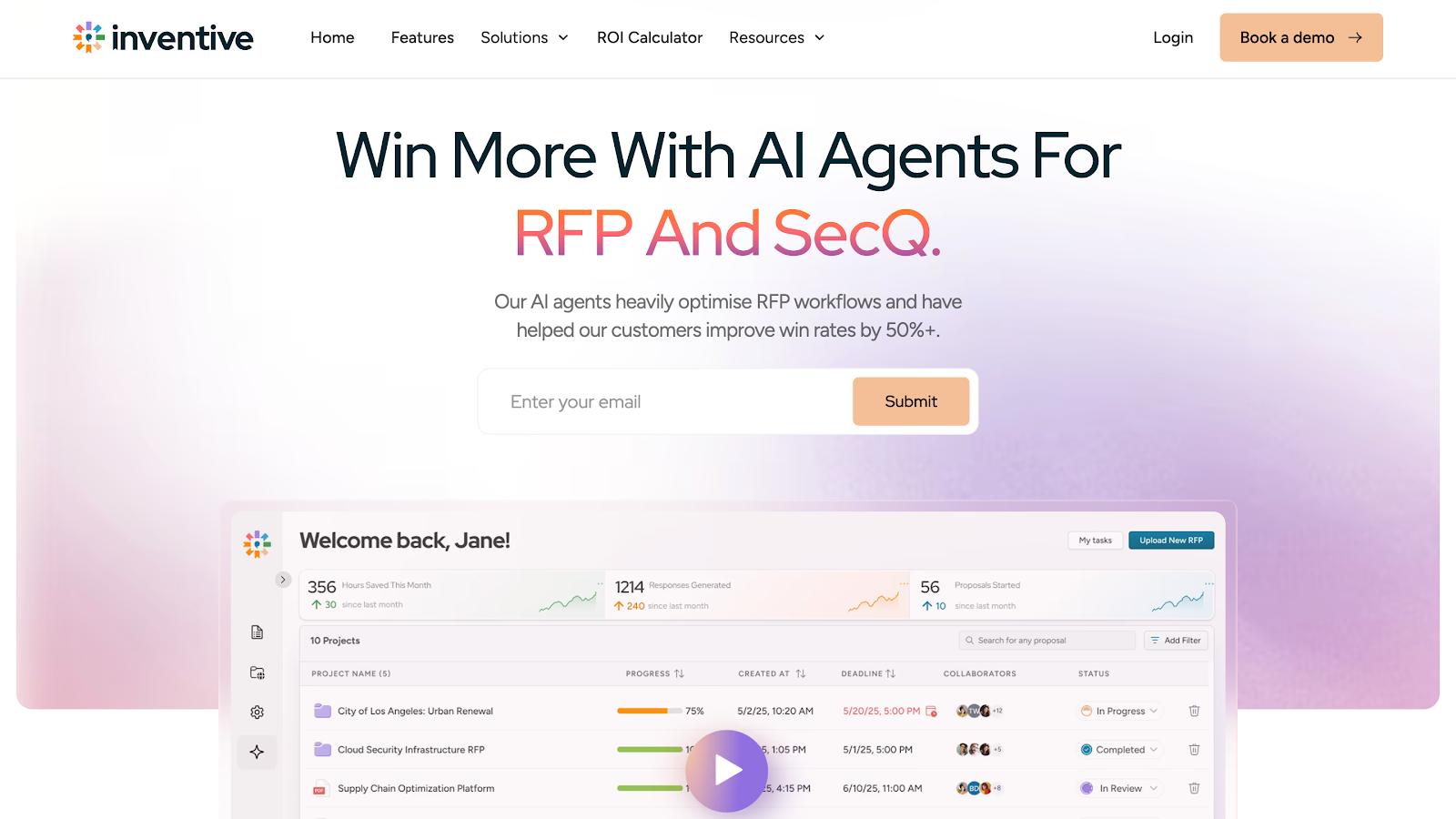
Inventive AI is the most advanced, enterprise-grade AI RFP Agent engineered for organizations across technology, healthcare, finance, pharmaceuticals, manufacturing, and government contracting. Built with a deep understanding of how global enterprises manage complex proposal cycles, Inventive AI transforms the RFP process into an intelligent, precision-driven operation.
By combining advanced AI with deep business context, Inventive AI generates fast, accurate, and fully tailored responses using your past proposals, CRM data, Slack threads, and even sales call transcripts. It identifies and weaves in strategic “Win Themes”, the exact value propositions that matter most to procurement committees and decision-makers.
Every proposal created through Inventive AI is audit-ready, compliance-aligned, and backed by real data. With real-time knowledge updates and auto-learning AI agents, your responses stay sharp, relevant, and consistent across every submission, outperforming competitors like Responsive AI in speed, accuracy, and adaptability.
Inventive AI isn’t another RFP tool, it’s the most advanced and reliable RFP intelligence system on the market, helping organizations respond faster, write smarter, and win more deals with measurable precision.
Key Features:
- AI RFP Agent: Drafts RFPs, RFIs, and security questionnaires with 95% accuracy, reducing turnaround time by up to 90%.
- Centralized Knowledge Hub: Organizes and stores critical proposal content, ensuring consistency and quick access to approved answers, templates, and past responses to enhance the accuracy and relevance of your proposals.
- AI Content Management: Identifies and flags inconsistencies or conflicting data across proposals before submission, ensuring that all responses are accurate, aligned, and ready for final review.
- Win Themes for Healthcare: Highlights differentiators relevant to payers and providers.
- Real-Time Collaboration: Supports role-based permissions and live editing.
- Advanced Analytics: Tracks response times, content usage, and win-rate metrics.
Pros:
- Optimized for compliance-heavy industries
- Conflict detection engine improves credibility
- Proven efficiency gains (90% faster) and increased win rates (50%+)
- Scales from mid-sized vendors to large enterprises
Cons:
- Limited analytics, as advanced reporting is still being expanded.
Best For:
- Large-scale RFPs, RFIs, and security questionnaires across global enterprises
- Compliance-driven responses in regulated industries
- AI-based content reuse for faster, higher-quality submissions
- Personalized, data-backed proposals that align with executive priorities
- Centralized, always up-to-date knowledge management across proposal operations
Gartner Ratings: 5/5
Inventive AI stands as the benchmark for intelligent RFP automation, trusted by enterprises across every major industry. With unmatched accuracy, adaptive learning, and AI that understands context as deeply as your own proposal experts, it helps organizations respond faster, reduce effort, and win with confidence.
2. Loopio

Loopio is known for its centralized content library that helps teams reuse approved answers for repetitive RFPs. However, it lacks deep contextual AI and the ability to generate strategic, value-driven responses for complex enterprise proposals.
Key Features:
- Centralized content library
- Collaboration workflows and approval tracking
- CRM integrations
- Analytics dashboards
Pros:
- Simple interface that’s easy to learn
- Decent content organization for repeat use
Cons:
- Struggles with contextual understanding and value-driven responses
- Heavy manual intervention required for quality output
- No real-time learning or advanced AI automation
Gartner Rating: 4.7/5
Loopio is suitable for managing repetitive content but falls short for enterprises that require intelligent, adaptive, and compliance-driven automation like Inventive AI provides.
Suggested Alternative: Inventive AI
For real estate enterprises needing more than content reuse, Inventive AI delivers context-aware automation, adaptive learning, and compliance-ready responses, helping teams create accurate, persuasive proposals 90% faster than Loopio.
3. Qvidian (Upland)
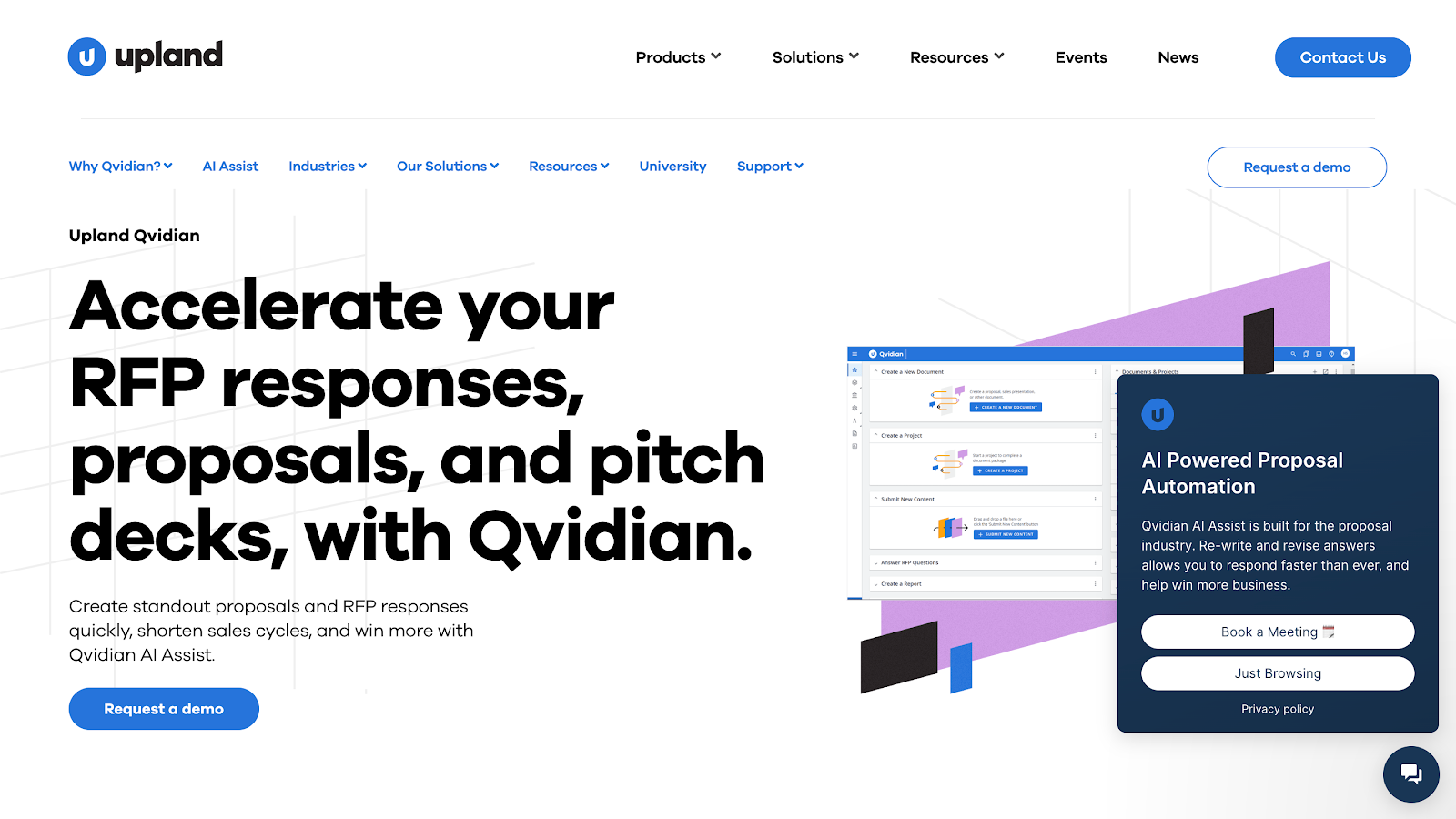
Qvidian offers enterprise-level automation for teams managing large numbers of proposals. Its templates, content management, and analytics allow organizations to maintain consistency and accelerate response cycles. However, its outdated UI and lack of real AI capabilities make it slow and rigid for modern proposal workflows.
Key Features:
- Proposal automation and template library
- Customizable dashboards for team performance
- Integration with CRM systems
- Role-based access and reporting
Pros:
- Handles complex, multi-office proposals
- Provides detailed analytics
Cons:
- Learning curve can be steep
- Outdated interface and slow performance
- Lacks real-time AI writing capabilities
- Minimal contextual awareness or data integration
Gartner Rating: 4.3/5
Qvidian is dependable for templated documents but fails to deliver the adaptability, intelligence, and real-time responsiveness that Inventive AI offers.
4. Proposify
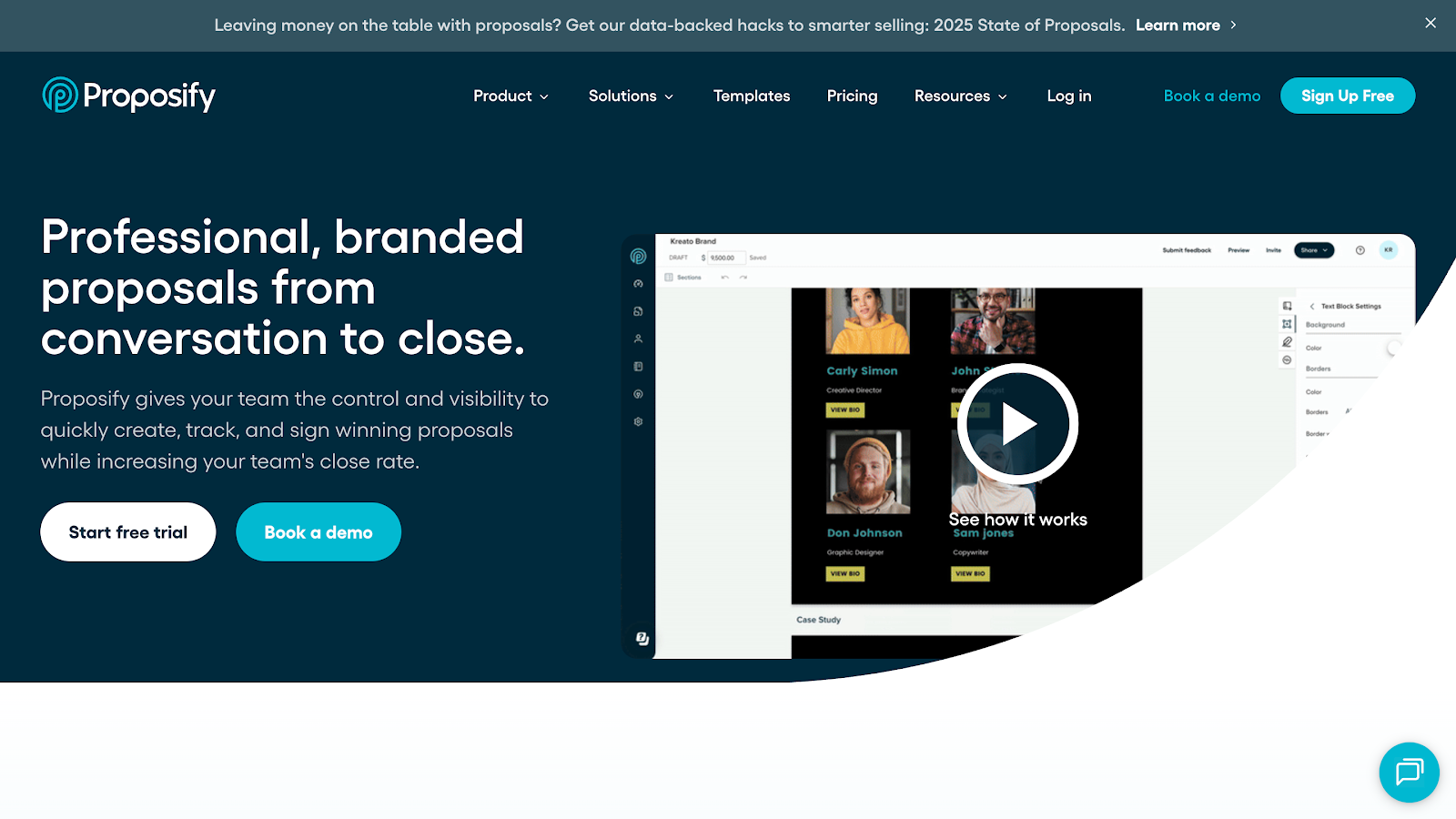
Proposify is a robust solution for proposal creation and management. It combines template customization, e-signatures, and analytics to help your team manage client proposals efficiently. However, it lacks enterprise-grade automation, AI depth, and compliance capabilities required for complex RFPs.
Key Features:
- Customizable templates and workflows
- E-signature integration
- Proposal analytics and tracking
- CRM integrations
Pros:
- Quick proposal creation with professional formatting
- Simple setup for SMBs
Cons:
- Limited AI functionality for automated responses
- Advanced features require higher-tier plans
- No compliance or content governance tools
- Not suitable for large-scale enterprise RFPs
Gartner Rating: 4.6/5
Proposify is effective for simple proposals but lacks the intelligence, speed, and governance that enterprises achieve with Inventive AI.
5. PandaDoc
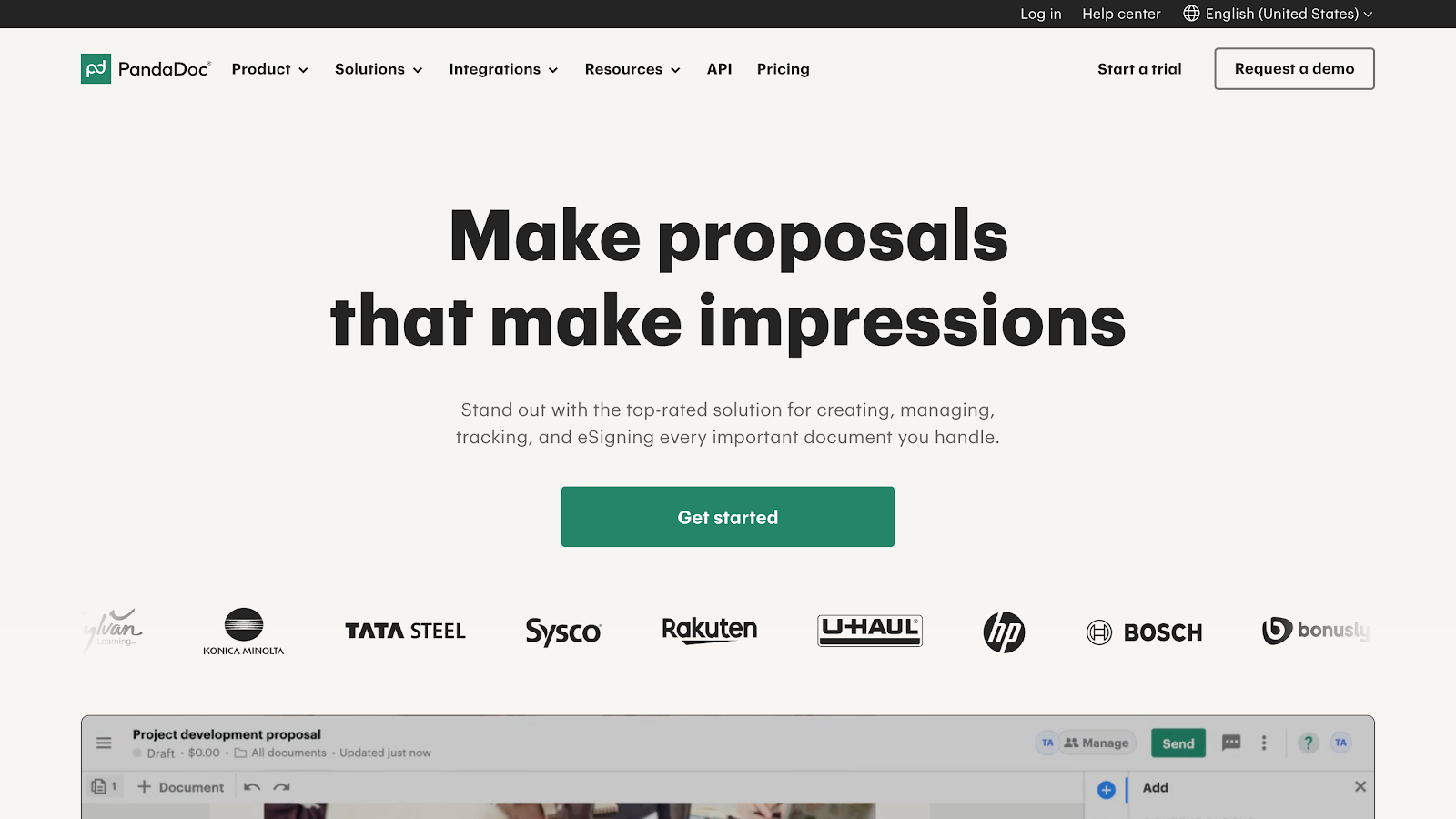
PandaDoc focuses on document creation and e-signatures, suitable for small to medium-sized firms. Its platform simplifies proposal management, allowing your team to create professional documents quickly. However, its not purpose-built for managing RFPs or compliance-heavy submissions.
Key Features:
- E-signature and document management
- Template library for proposals
- CRM and Google Drive integration
- Progress tracking
Pros:
- Fast document creation and approval
- Easy-to-use interface
Cons:
- Limited support for complex multi-stakeholder proposals
- AI automation is minimal
- Lacks AI for contextual responses
- No support for complex compliance or audit trails
Gartner Rating: 4.7/5
PandaDoc simplifies document workflows but does not meet the advanced requirements of enterprises handling regulated or high-stakes RFPs. Inventive AI far exceeds its automation and intelligence capabilities.
6. SAP Ariba
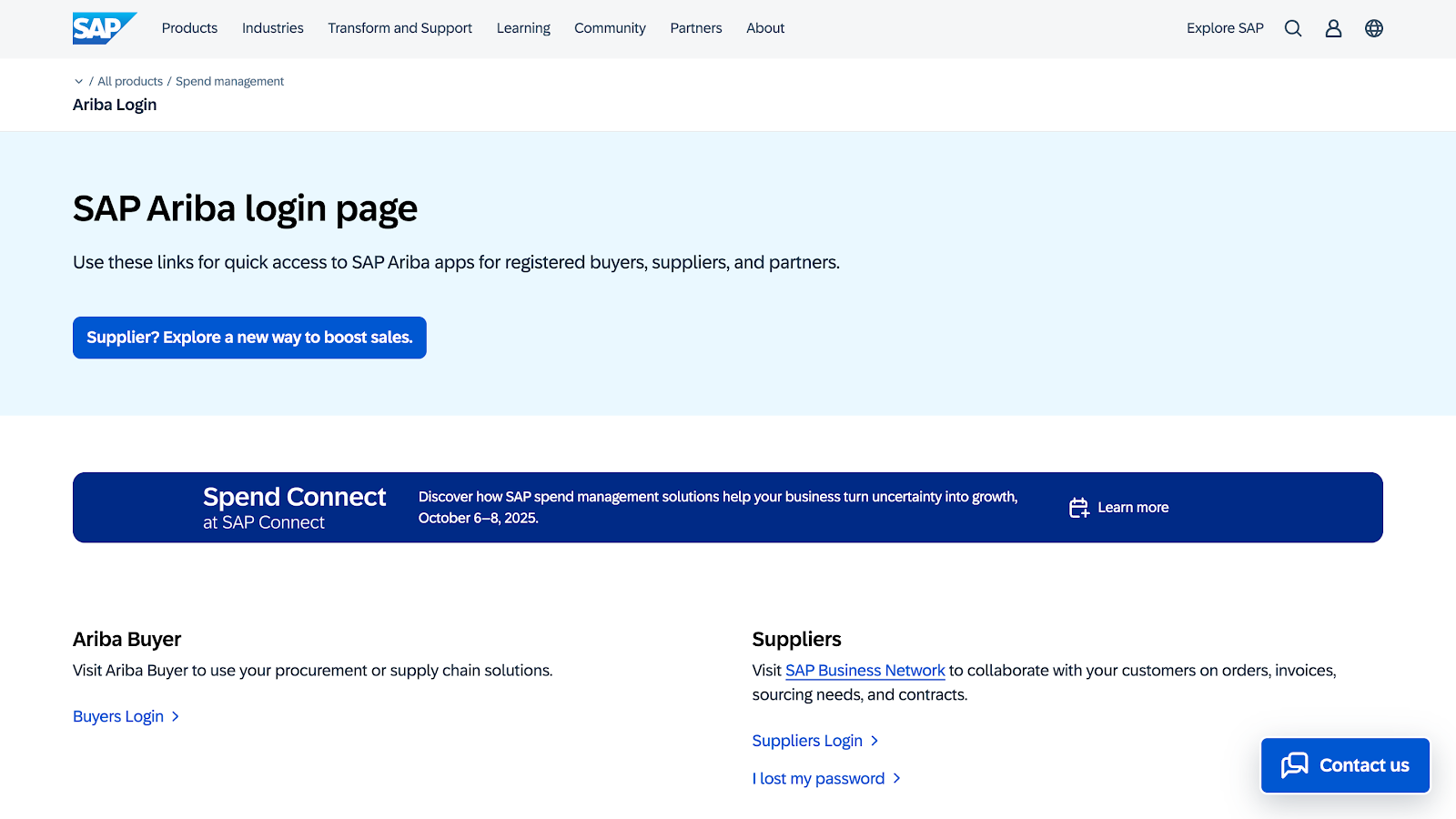
SAP Ariba is a global procurement and supply chain solution that includes comprehensive RFP management. It integrates deeply with enterprise resource planning (ERP) systems, making it ideal for large organizations with complex sourcing needs. However, it offers little support for AI-based authoring or real-time collaboration on RFPs.
Key Features:
- End-to-end procurement and sourcing workflows
- Built-in compliance and supplier risk management
- Integration with SAP and third-party ERP systems
- Supplier network for broader vendor reach
Pros:
- Enterprise-grade solution with strong compliance features
- Wide supplier network offering greater vendor choice
Cons:
- Steeper learning curve compared to simpler platforms
- Higher implementation and licensing costs
- Best suited for large enterprises, may be excessive for SMEs
- Complicated setup for non-technical users
Gartner Rating: 4.0/5
Ariba is reliable for procurement but ineffective for intelligent proposal creation. Inventive AI bridges this gap by delivering smart automation alongside enterprise-grade compliance.
7. AutoRFP AI
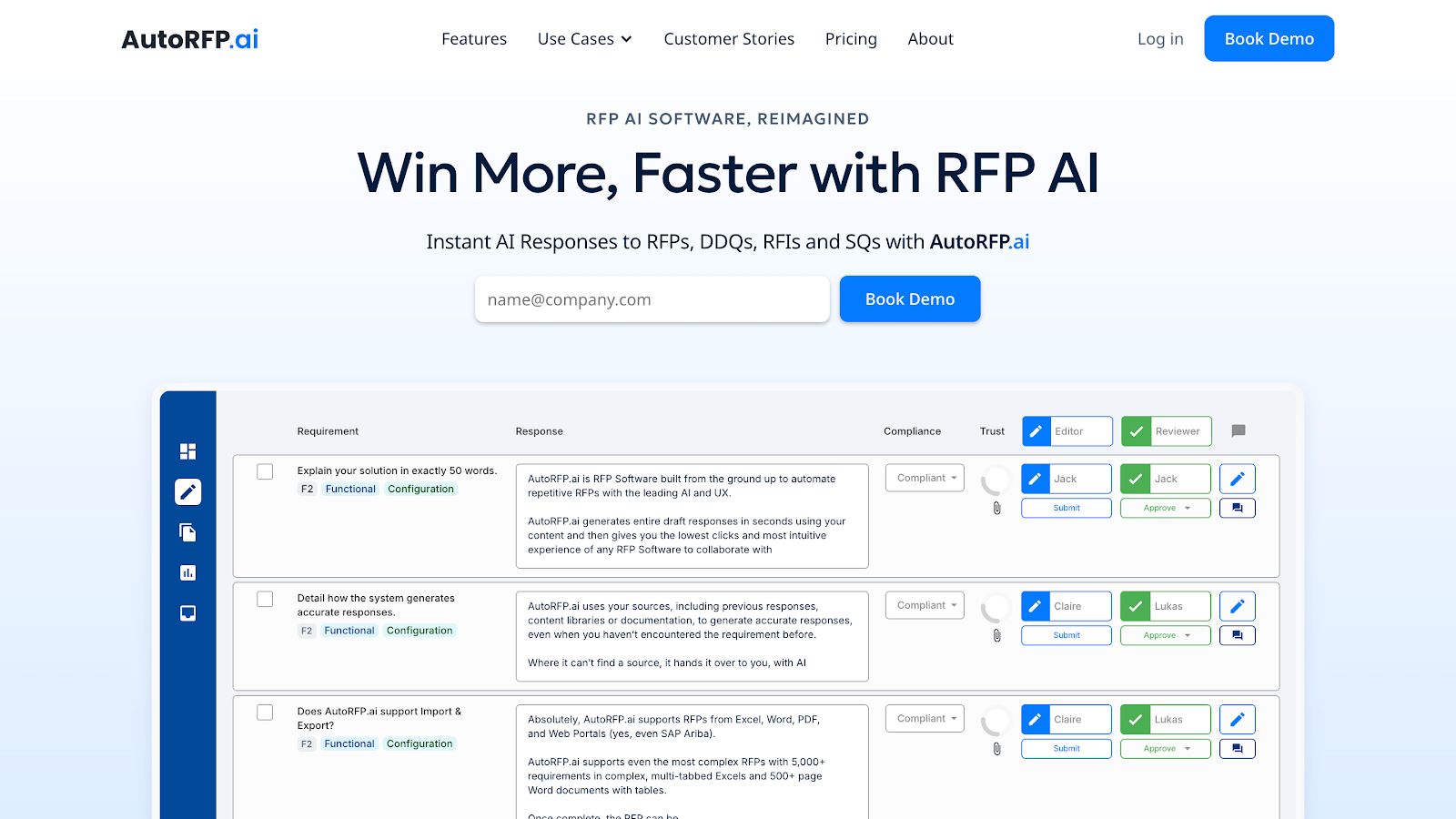
AutoRFP AI is an AI-driven RFP automation platform. It helps firms quickly generate accurate proposal drafts, improving speed and efficiency. However, it lacks the intelligence, accuracy, and governance standards required by enterprises.
Key Features:
- AI-assisted response drafting
- CRM and document management integrations
- Machine learning to improve accuracy
- Rapid response generation
Pros:
- Good entry point for small businesses
- Requires minimal onboarding effort
Cons:
- Weak contextual understanding and accuracy
- No enterprise compliance or version control
- Struggles with complex, regulated proposals
- Smaller community support compared to established players
Gartner Rating: 5/5
AutoRFP AI focuses on speed but sacrifices precision and control. Inventive AI delivers both, ensuring faster, higher-quality responses without compromising compliance or context.
Suggested Alternative: Inventive AI
For firms that need both speed and precision, Inventive AI goes beyond AutoRFP AI—offering 95% response accuracy, real-time knowledge updates, and enterprise-grade compliance for complex real estate proposals.
8. NetSuite
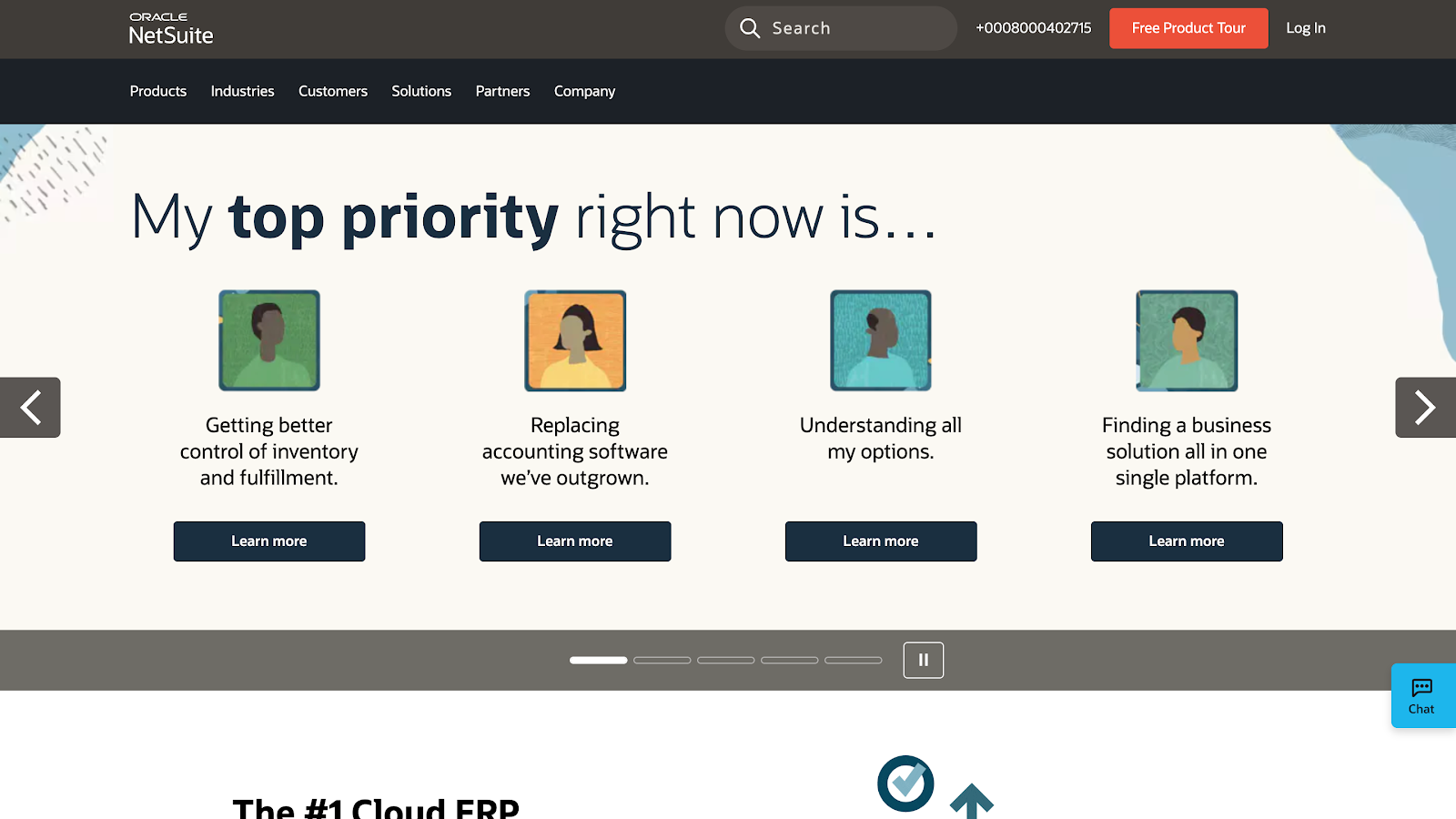
NetSuite provides integrated ERP RFP and procurement management. Its cloud-based platform centralizes vendor evaluation, scoring, and decision-making. Organizations benefit from real-time analytics, automated workflows, and a consistent framework for evaluating ERP vendors. However, it lacks the specialized AI and RFP-focused capabilities enterprises need for fast, accurate, and compliant proposal generation.
Key Features:
- Vendor management and procurement modules
- Real-time dashboards and analytics
- Centralized ERP evaluation workflows
Pros:
- Easy ERP integration
- Strong reporting capabilities
Cons:
- Customization and setup require resources
- Best suited for organizations already on NetSuite
- Limited contextual accuracy and proposal governance
Gartner Rating: 4.1/5
NetSuite supports operational workflows, but it’s not built for RFP excellence. Inventive AI brings the intelligence, speed, and customization NetSuite lacks.
9. XaitPorter
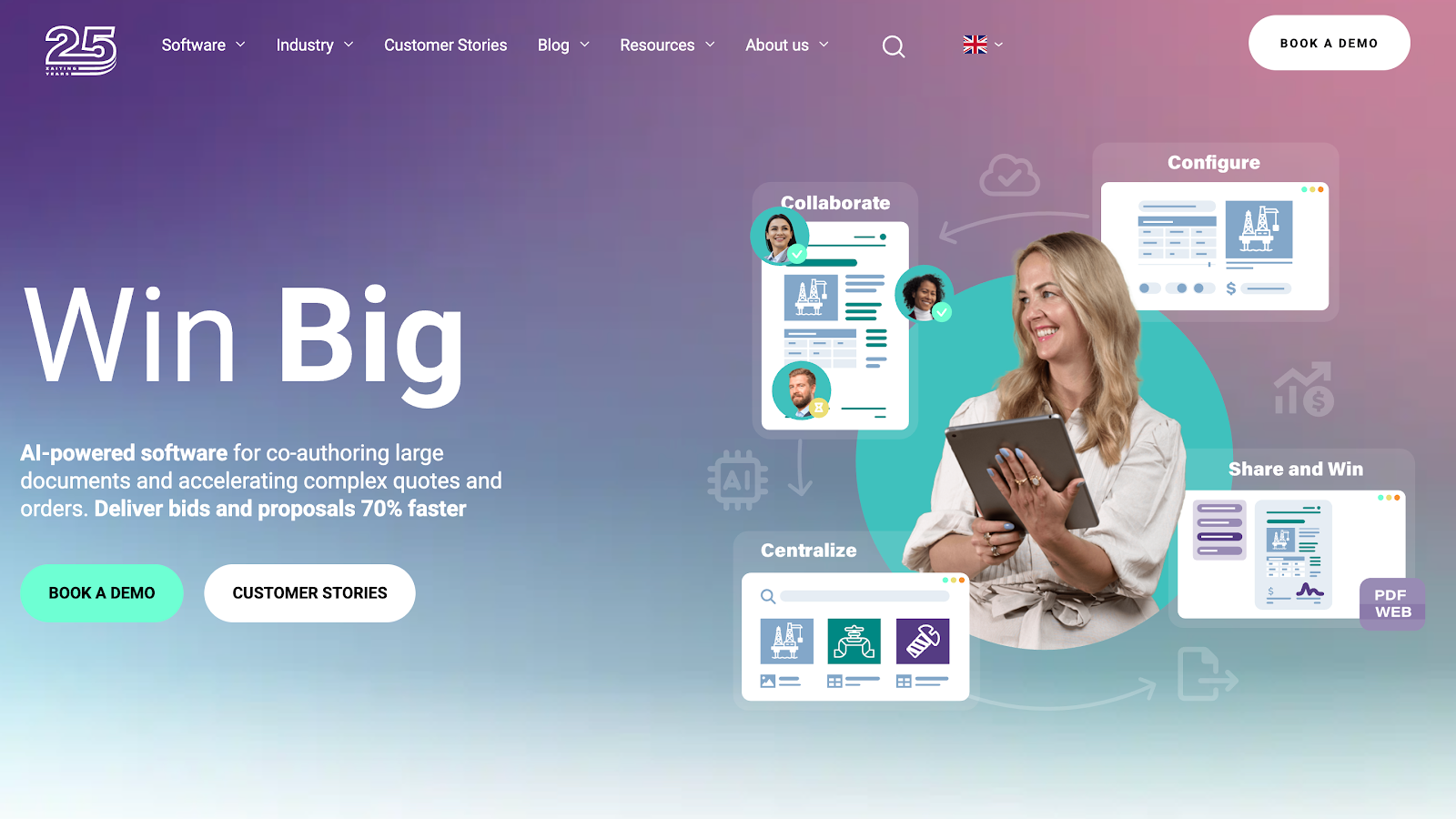
XaitPorter is a collaborative document management platform for large, complex proposals. It allows multiple contributors to work in real-time while maintaining structure and consistency. However, it lacks advanced AI, making it slow and outdated for modern proposal cycles.
Key Features:
- Real-time document collaboration
- Workflow management
- CRM and document system integration
- Cloud-based remote access
Pros:
- Tracks changes and approvals
- Supports remote collaboration
Cons:
- Requires training for new users
- Limited AI-based automation
- Outdated interface and limited scalability
Gartner Rating: N/A
XaitPorter works for static documentation but doesn’t match the speed, precision, or intelligence delivered by Inventive AI’s real-time AI RFP Agent.
10. Sequesto

Sequesto is a modern RFP and questionnaire management platform designed to optimize large-scale proposal workflows. It utilises AI to comprehend context and phrasing, enabling teams to deliver accurate and relevant responses more quickly. However, it lacks the AI sophistication, scalability, and compliance control that large enterprises demand.
Key Features:
- AI-driven content autofill that understands context, not just keywords
- Real-time collaboration with live edits
- Built-in content governance and approval workflows
- Multilingual support for international RFPs
Pros:
- Faster turnaround times with AI-assisted drafting
- Reduces errors and inconsistencies in responses
- Supports global teams with multilingual capabilities
Cons:
- Requires a structured setup to leverage AI features fully
- It may be more complex than needed for small teams
- Lacks depth for enterprise requirements
Gartner Rating: 4.6/5
Sequesto may handle basic RFP tasks but doesn’t scale or perform at enterprise levels. Inventive AI stands far ahead with unmatched intelligence, automation, and performance precision.
This comprehensive comparison of top RFP software helps evaluate which solution best fits an organization’s needs. Whether prioritizing AI-powered drafting, strong compliance features, or seamless integration, there is a solution that can optimize proposal processes and increase win rates.
How to Choose the Best RFP Software for Your Business
Selecting the right RFP software is essential for optimizing your proposal process and increasing your win rates. Here's a structured approach to help you make an informed decision:
1. Evaluate Automation Potential
Focus on how well the software automates everyday bottlenecks, from content search and proposal generation to approvals. The right platform should eliminate repetitive work, reduce review cycles, and maintain accuracy at every step. Advanced AI-driven automation can turn days of manual effort into hours, freeing you to focus on crafting the strategy that wins deals.
2. Assess Integration Capabilities
Your RFP software should fit into your ecosystem, not force you to rebuild it. Look for deep integrations with tools like Salesforce, HubSpot, SharePoint, or your document management systems. Seamless connections keep data flowing effortlessly between systems, remove manual updates, and ensure everyone works from the same, most accurate information.
3. Prioritize Content Intelligence
Modern RFP platforms should do more than match keywords, they should understand context. Choose software with AI-powered content intelligence that recommends high-quality answers based on previous responses, customer needs, and evaluation patterns. The smarter the content engine, the more persuasive and consistent your proposals become.
4. Verify Implementation Speed and Support
Time to value matters. Evaluate how quickly the vendor can help you onboard, migrate your content, and train your users. A provider with strong implementation support and clear post-deployment guidance ensures a smoother transition and faster ROI.
5. Calculate True Cost of Ownership
Do not stop at the licensing fee. Account for training, support, and long-term scalability. The most cost-effective tool is not the cheapest, it is the one that consistently saves you time, improves accuracy, and raises your win rate over the long run.
When selecting RFP software, look for a platform that automates intelligently, integrates deeply, and learns continuously from your data. The right solution should help your organization respond faster, reduce manual effort, and turn every proposal into a measurable growth opportunity.
Inventive AI delivers all of this, and more. It combines advanced automation, deep system integrations, and adaptive AI learning to transform how enterprises manage proposals.
Common Challenges RFP Response Teams Face

RFP response teams often encounter several roadblocks that make the RFP process cumbersome and time-consuming. Identifying these challenges will help you select software that directly addresses them:
1. Manual Processes
RFP teams still spend hours digging through old files or rewriting answers from scratch. This not only delays submissions but also eats into valuable selling time.
Choose a platform that automates content search, response generation, and formatting. AI-powered systems like Inventive AI can recall and adapt approved answers in seconds, giving you a 90% faster turnaround without sacrificing accuracy.
2. Inconsistent Messaging
When multiple contributors work in silos, proposals often sound fragmented — a major credibility killer during evaluation.
Use software with a centralized content hub that enforces consistent messaging and tone. With Inventive AI, your brand voice, facts, and value propositions stay uniform across every proposal, regardless of who contributes.
3. Resource Allocation Bottlenecks
Subject Matter Experts get pulled into multiple RFPs, causing delays and burnout. Valuable expertise ends up spread too thin.
Automate knowledge reuse. With Inventive AI’s intelligent content repository, SMEs only need to review updates, not start from zero, freeing up their time for higher-value tasks while maintaining accuracy.
4. Slow Approvals and Endless Email Chains
When approvals depend on email threads and spreadsheets, things fall through the cracks, leading to rushed, last-minute submissions.
Pick a platform with built-in collaboration and role-based approvals. Inventive AI enables real-time editing, version control, and instant visibility for reviewers, keeping every proposal on track and on time.
5. Lack of Competitive Intelligence
Without visibility into what works, it’s hard to improve future responses or understand why deals are lost.
Go for a tool with embedded analytics and content performance tracking. Inventive AI gives you insight into which responses win most often, helping you fine-tune future proposals and outsmart competitors.
Every one of these challenges is solvable with the right technology. Platforms like Inventive AI eliminate repetitive work, maintain message accuracy, accelerate collaboration, and deliver the insights needed to win more consistently. With the right system in place, your RFP process stops being reactive, and starts becoming a strategic advantage.
Why Inventive AI Leads the Future of RFP Response
Inventive AI is a next-generation AI-powered RFP response platform built for organizations across technology, healthcare, finance, pharmaceuticals, manufacturing and government contracting. It redefines how enterprises handle proposals by combining automation, centralized knowledge, and intelligent agents.
Powered by its AI-Response engine, Inventive AI enables users to generate draft responses rooted in their knowledge sources and collaborate in real-time to refine them. Its unified knowledge hub allows users to upload past RFPs, documents, Q&A banks and integrate internal systems like Google Drive, SharePoint, and Slack, enabling a centralized content foundation.
With built-in project management capabilities and AI agents that clarify requirements, identify differentiators, and organize tasks, Inventive AI simplifies the entire RFP process—from the first draft to final submission.
Proven Results with Inventive AI
- 50% higher win rates across enterprise customers
- 90% faster RFP completion times
- 2.5× more RFP submissions within the first three months of adoption
- 95% AI-driven response accuracy
- SOC 2-compliant security for data protection and enterprise trust
Inventive AI isn’t just another RFP tool; it is a full solution for organizations that want to respond faster, reduce manual effort, and produce compliant, high-quality proposals.
Also Read: How to Write a Winning RFP
Here’s what our clients say:
What Our Clients Say
Frequently Asked Questions (FAQs)
1. How do AI-driven RFP platforms handle industry-specific compliance requirements?
AI-powered RFP platforms are designed to cater to the unique compliance needs of various industries. They integrate regulatory frameworks such as HIPAA, SOC 2, and ISO certifications into their content libraries, ensuring that responses are not only accurate but also compliant with industry standards. This integration allows teams to generate audit-ready proposals efficiently, reducing the risk of non-compliance and enhancing the credibility of their submissions.
2. What role does centralized content management play in RFP response efficiency?
Centralized content management serves as the backbone of efficient RFP responses. By consolidating approved answers, templates, and standard responses in a single repository, teams can quickly access and reuse content, ensuring consistency and accuracy across proposals. This approach not only speeds up the response process but also minimizes errors and maintains a unified voice in all submissions.
3. How do collaboration tools within RFP software enhance team productivity?
Collaboration tools within RFP software facilitate seamless teamwork by enabling real-time editing, role-based permissions, and progress tracking. These features ensure that all team members are aligned, reducing bottlenecks and miscommunications. By streamlining the review and approval processes, teams can meet tight deadlines and produce high-quality proposals more efficiently.
4. In what ways do analytics and reporting features contribute to continuous improvement in RFP responses?
Analytics and reporting features provide valuable insights into the RFP response process, allowing teams to track metrics such as response times, win rates, and content effectiveness. By analyzing this data, organizations can identify areas for improvement, refine their strategies, and make data-driven decisions to enhance future proposal outcomes. This continuous feedback loop fosters a culture of improvement, increasing the likelihood of success in competitive bidding scenarios.


